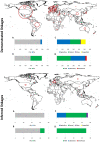Artefactual depiction of predator-prey trophic linkages in global soils
- PMID: 34903745
- PMCID: PMC8668944
- DOI: 10.1038/s41598-021-03234-7
Artefactual depiction of predator-prey trophic linkages in global soils
Abstract
Soil invertebrates contribute to multiple ecosystem services, including pest control, nutrient cycling, and soil structural regulation, yet trophic interactions that determine their diversity and activity in soils remain critically understudied. Here, we systematically review literature (1966-2020) on feeding habits of soil arthropods and macrofauna and summarize empirically studied predator-prey linkages across ecosystem types, geographies and taxa. Out of 522 unique predators and 372 prey organisms (constituting 1947 predator-prey linkages), the vast majority (> 75%) are only covered in a single study. We report a mean of just 3.0 ± 4.7 documented linkages per organism, with pronounced taxonomic biases. In general, model organisms and crop pests (generally Insecta) are well-studied, while important soil-dwelling predators, fungivores and detritivores (e.g., Collembola, Chilopoda and Malacostraca) remain largely ignored. We argue that broader food-web based research approaches, considering multiple linkages per organism and targeting neglected taxa, are needed to inform science-driven management of soil communities and associated ecosystem services.
© 2021. The Author(s).
Conflict of interest statement
The authors declare no competing interests.
Figures





References
-
- Wall DH, Bardgett RD, Kelly E. Biodiversity in the dark. Nat. Geosci. 2010;3(5):297–298.
-
- Koch A, McBratney A, Adams M, Field D, Hill R, Crawford J, Minasny B, Lal R, Abbott L, O'Donnell A, Angers D. Soil security: Solving the global soil crisis. Global Pol. 2013;4(4):434–441.
-
- Wall DH, Nielsen UN, Six J. Soil biodiversity and human health. Nature. 2015;528(7580):69–76. - PubMed
Publication types
LinkOut - more resources
Full Text Sources

